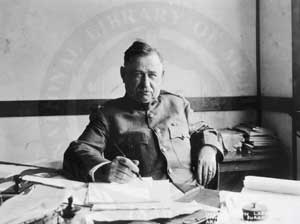War Department’s Creation of the Typhoid Board Headed by Walter Reed
Surgeon-General George Sternberg requested a board of investigation, which the War Department created on August 18, 1898. Representatives of the United States and Spain had signed a Protocol of Peace six days earlier. Much of the expanded American army, however, would remain intact through February 1899, when the two nations approved a treaty of peace.
Walter Reed, Edward O. Shakespeare, and Victor C. Vaughan

Walter Reed
The Department appointed three army surgeons recommended by the Surgeon-General: Major Walter Reed, designated President of the board, and Majors Edward O. Shakespeare and Victor C. Vaughan. The appointment order directed the three men to uncover the cause of the disease’s prevalence. At each stricken training-camp they would draw attention to any unsanitary conditions and recommend corrective measures.
Reed was America’s leading military expert on the scientific diagnosis of typhoid. In 1896, as curator of the Army Medical Museum and Professor of Bacteriology and Clinical Microscopy in the Army Medical School, he “repeatedly exercised” students in an adaptation of the newly developed Widal method, the first effective serodiagnostic test for the disease. Using blood samples solicited from military hospitals throughout the nation, Reed also performed a broader demonstration of the Widal test’s high degree of accuracy, a demonstration that Sternberg promptly publicized in his report for fiscal year 1897.
Shakespeare was a bacteriologist and ophthalmologist who had uncovered the origins of an especially baffling typhoid epidemic in Pennsylvania. Vaughan, a public-health innovator, had investigated typhoid outbreaks throughout the upper Midwest.

Victor C. Vaughan. From the U.S. National Library of Medicine
Typhoid in Stateside Army Training Camps
The Typhoid Board’s members began their work by visiting the Army’s training camps at Huntsville, Alabama; Fernandina and Jacksonville, Florida; Chickamauga, Georgia; Montauk Point, New York; Middletown, Pennsylvania; Knoxville, Tennessee; and Falls Church, Virginia. Between August 1898 and June 1900, when the Board disbanded, it also issued a host of sanitary recommendations and evaluated the medical histories of 92 regiments, basic organizational components of about 1,300 men each and containing collectively over 100,000 men.
Typhoid Board Issues Reports
With the assignment of Reed to other investigative bodies and the subsequent deaths of Shakespeare and Reed, in 1900 and 1902 respectively, Vaughan emerged as the Typhoid Board’s chief publicist. In a May 1899 presentation to the Association of American Physicians, he issued what was essentially the Board’s preliminary public report. One year later Vaughan and his colleagues delivered to Sternberg a report composed of nearly 3,000 manuscript pages and 100 maps and charts. The War Department published an abstract in 1900 and a more complete version, Report on the Origin and Spread of Typhoid Fever in U.S. Military Camps during the Spanish War of 1898, edited by Vaughan, in 1904. That final report, like the abstract of 1900, offered 57 “general statements and conclusions.”